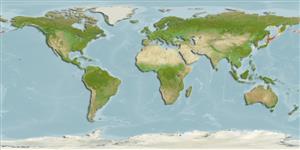Teleostei (teleosts) >
Perciformes/Cottoidei (Sculpins) >
Agonidae (Poachers) > Bothragoninae
Etymology: Bothragonus: Greek, bostrykos = cure of lack of hair + Greek, gono = birth (Ref. 45335).
Environment: milieu / climate zone / depth range / distribution range
Ecology
Marine; demersal; depth range 0 - 100 m (Ref. 56557). Temperate
Northwest Pacific: Hokkaido and Habomai islands in Japan and from Peter the Great Bay.
Size / Weight / Age
Maturity: Lm ? range ? - ? cm
Max length : 7.0 cm TL male/unsexed; (Ref. 56557)
Short description
Identification keys | Morphology | Morphometrics
Life cycle and mating behavior
Maturities | Reproduction | Spawnings | Egg(s) | Fecundities | Larvae
Masuda, H., K. Amaoka, C. Araga, T. Uyeno and T. Yoshino, 1984. The fishes of the Japanese Archipelago. Vol. 1. Tokai University Press, Tokyo, Japan. 437 p. (text). (Ref. 559)
IUCN Red List Status (Ref. 130435)
Threat to humans
Harmless
Human uses
Tools
Special reports
Download XML
Internet sources
Estimates based on models
Preferred temperature (Ref.
123201): 4.2 - 16.8, mean 11.5 °C (based on 52 cells).
Phylogenetic diversity index (Ref.
82804): PD
50 = 0.7500 [Uniqueness, from 0.5 = low to 2.0 = high].
Bayesian length-weight: a=0.00389 (0.00180 - 0.00842), b=3.12 (2.94 - 3.30), in cm total length, based on all LWR estimates for this body shape (Ref.
93245).
Trophic level (Ref.
69278): 3.2 ±0.1 se; based on size and trophs of closest relatives
Resilience (Ref.
120179): High, minimum population doubling time less than 15 months (Preliminary K or Fecundity.).
Fishing Vulnerability (Ref.
59153): Low vulnerability (10 of 100).
Nutrients (Ref.
124155): Calcium = 166 [79, 403] mg/100g; Iron = 0.636 [0.300, 1.283] mg/100g; Protein = 16.7 [15.2, 18.1] %; Omega3 = 0.742 [0.287, 2.160] g/100g; Selenium = 11.6 [4.8, 30.6] μg/100g; VitaminA = 27.1 [6.7, 102.9] μg/100g; Zinc = 1.07 [0.71, 1.63] mg/100g (wet weight);
